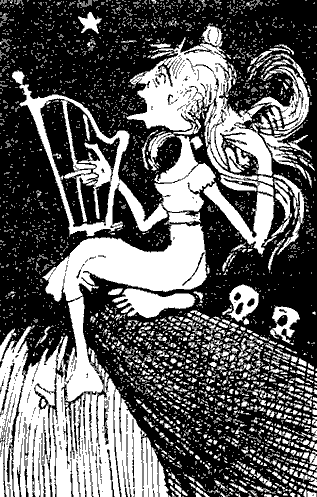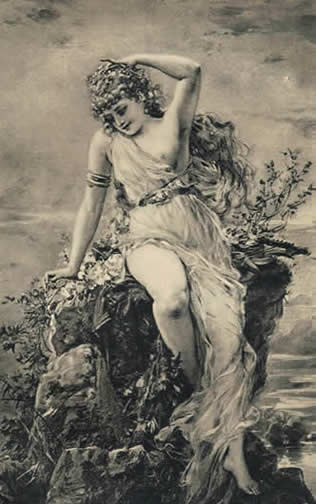SPECIAL FEATURE
by Barbara Schmidt
A History of and Guide to
UNIFORM EDITIONS OF MARK TWAIN'S WORKS
"It is a book written by one loafer for a brother loafer
to read."
- Samuel Clemens interview in New York World, 11 May 1879
Chapter 10
Brief Overview of Volumes 3 and 4:
A Tramp Abroad
Dividing the Work
A Tramp Abroad was first published by American Publishing Company in March 1880. It was a travelogue based on the time Clemens spent in Europe between April 1878 and August 1879. The first edition is a massive subscription book of 157,000 words in 50 chapters and 6 appendixes. It features 328 illustrations by artists Walter Francis Brown, True W. Williams, Benjamin Henry Day, William Wallace Denslow and adaptations of previously published illustrations by James Carter Beard, Roswell Morse Shurtleff and Edward Whymper. Many of the illustrations were imbedded on the page with text flowing around them. In addition, Clemens himself contributed at least 10 or more pictures to the 1880 edition. In order to maintain uniformity in size with other volumes in the 1899 uniform edition sets, Frank Bliss divided A Tramp Abroad into two separate books which became not only Volumes 3 and 4, but also parts 1 and 2 of the title work itself. Almost all of the original illustrations were eliminated and new printing plates produced. Running page headings that were present throughout the first edition were eliminated. Volume 3 of the uniform edition ends with Chapter 29. Volume 4 begins with new chapter numbering and what was once Chapter 30 from the first edition is Chapter 1 of Volume 4.
Refining the Work
While the new uniform edition of A Tramp Abroad offered Clemens an opportunity to revise and refine his work, no detailed comparison of the text to the 1880 first edition has been conducted. However, when passages in the original text referred to illustrations that had been eliminated from the uniform edition, these passages were deleted. For example, Chapter 12 of the first edition describes children playing barefooted in the street. Illustrator Walter Francis Brown drew children wearing shoes for an illustration titled "Generations of Bare Feet." Clemens chided the illustrator in a footnote at the bottom of the page "I certainly thought them barefooted, but evidently the artist has had doubts" (Twain, 1880, p. 113).
Two surprising revisions are found in the visual presentations of A Tramp Abroad in the uniform editions -- the relocation of the illustration titled "Titian's Moses" and the selection of one new and uncredited illustration titled "Lorelei" (both discussed below). It is unlikely that any of the revisions were made by Clemens and are more likely the work of Frank Bliss.
Production of the new 1899 plates also had the potential to introduce inconsistencies into the texts that were the result of typesetting errors.
|
Frank Bliss intended to correct any errors for subsequent printings and hired Forrest Morgan (b. 1852 - d. 1924), a fastidious proofreader, to weed out errors. Morgan, a former editor of the Hartford Travelers Record and later an assistant librarian at Watkinson Library in Hartford, read from a set of the Royal Edition to mark errors. Clemens was familiar with the work of Forrest Morgan in Travelers Record. When Clemens wrote "Stirring Times in Austria" in 1897 he quoted from a long passage he credited to Morgan to describe the history of disunity in the Austro-Hungarian empire. "Stirring Times in Austria" was published in Harper's Monthly in March 1898 and is reprinted in Volume 22. Morgan's 22-volume set of the Royal Edition with his annotations is in the Beinecke Rare Book and Manuscript Library at Yale University, a gift from William Lyon Phelps in 1922. No examination of Morgan's notes for A Tramp Abroad has been conducted. |
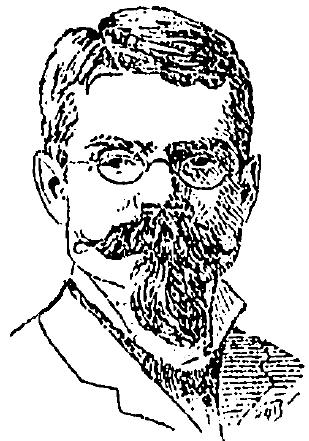 Forrest Morgan, proofreader for the 1899 uniform edition, helped refine the works for subsequent editions. |
W. H. W. Bicknell's Contributions
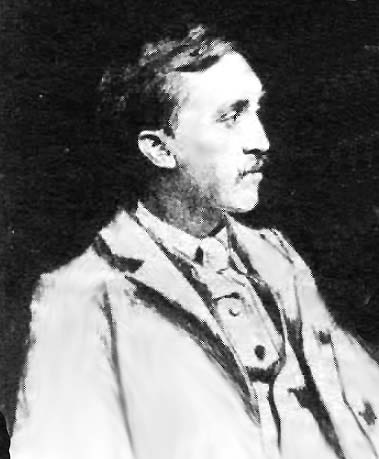 William Harry Warren Bicknell photo courtesy of the Winchester, Massachusetts Archival Center |
Frank Bliss hired new illustrators for the 1899 uniform edition. Artist and etcher William Harry Warren Bicknell (b. 1860 - d. 1947) was born in Boston, Massachusetts, the son of a grocer. Bicknell graduated from the Boston Latin School in 1878 and later studied at the Boston Museum of Fine Arts. He was a pupil of Otto Grundmann and Frederic Crowningshield. Bicknell etched a number of frontispieces made from photographs of Clemens that were used throughout the set. Bicknell's etching of the Tiffany monogram appears as a title page in every volume of the Autograph Edition, Edition De Luxe, Japan Edition, Author's De Luxe Edition, and the Royal Edition. All of these editions began issuing in 1899. Less expensive editions such as Underwood, Riverdale, and Hillcrest feature the Tiffany title page in Volume 1 only. It was elimnated altogether from the Author's National Edition. |
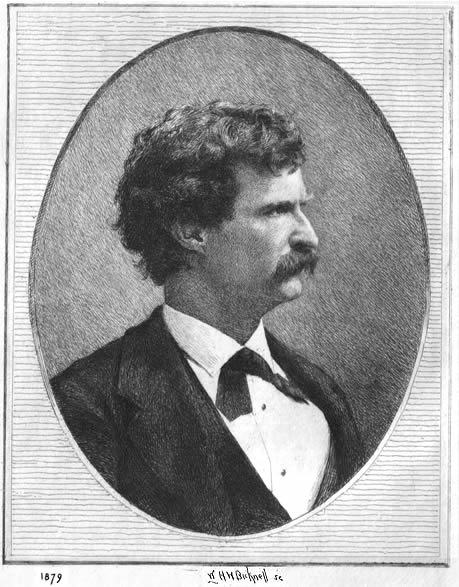
Frontispiece
of Volume 3 etched by William Harry Warren Bicknell based on a photograph
of Mark Twain from 1879.
Thure de Thulstrup, Illustrator
Frank Bliss hired artist Thure de Thulstrup (b. 1848 - d. 1930) to furnish six full-page illustrations for Volumes 3 and 4 of the uniform edition of A Tramp Abroad.. De Thulstrup was born in Sweden on April 5, 1848, the son of Magnus de Thulstrup who was a former Swedish Minister to France. Thure de Thulstrup was educated at the National Military Academy in Stockholm. He was commissioned in the French Army after graduation and served in Algiers. After his military commission expired, he studied art in Paris. From France, he traveled to Canada and worked as a topographical engineer and then went to New York where he obtained work as an artist on the New York Daily Graphic. He eventually ended up at Harper's Weekly working alongside Thomas Nast and held a position of staff artist there for twenty years documenting such events as the funeral of President Ulysses S. Grant and Queen Victoria's Diamond Jubilee for American readers.
Some correspondence between Thulstrup and Frank Bliss survives
in the in the special
collections at the University of Virginia. A letter from Thulstrup to
Bliss dated April 17, 1899 indicates he was still waiting to be paid for
his artwork.
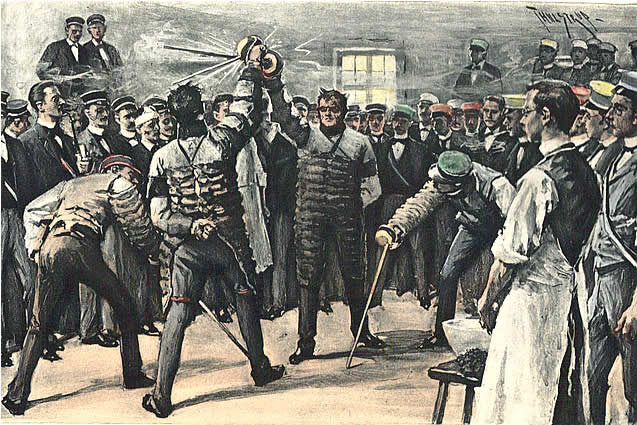
Thure de Thulstrup's
"The Deluge of Blows Began" appears in A Tramp Abroad, Volume
3 as a black and white illustration. It was hand-colored and used as the
frontispiece of Volume 3 of the Riverdale
Edition issued in 1901.
Thulstrup's illustrations for the 1899 uniform edition of A Tramp Abroad lack the sense of humor and playfulness that Walter Francis Brown, True Williams and other illustrators brought to the first edition.
"Titian's Moses" - Retained and Relocated
The 1880 first edition of A Tramp Abroad featured two frontispieces. The first was a portrait of Mark Twain by engraver J. A. J. Wilcox of Boston based on the same photograph Bicknell engraved for Volume 3 of the 1899 uniform edition. The second frontispiece of the 1880 edition was an illustration titled "Titian's Moses" engraved by Adolphe Francois Pannemaker (b. 1822 - d. 1900) and based on the famous painting by Paul Delaroche (b. 1797 - d. 1856) titled "Miriam and Moses."
 "Titian's Moses" -- composite by Mark Twain based on Paul Delaroche's painting |
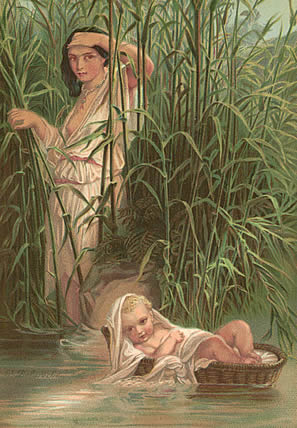 "Miriam and Moses" by Paul Delaroche from Harriet Beecher Stowe's Woman in Sacred History published in 1873. |
On 10 June 1879 Clemens wrote Frank Bliss from Paris and described his handiwork "Titian's Moses"

